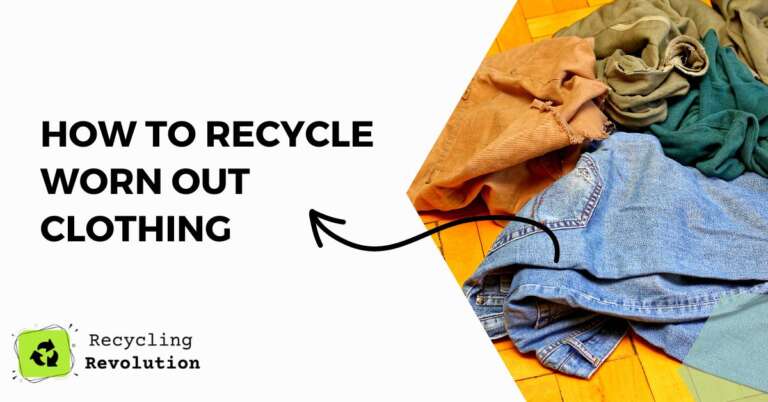In our ever-evolving world, it’s become increasingly clear that we all have a responsibility to tread lightly on this Earth. One major contributor to environmental degradation?
Fast fashion and the endless cycle of buying, discarding, and then buying again. But what do you do when your beloved garments start showing signs of wear and tear?
Instead of simply tossing them away, recycling worn-out clothing is the sustainable answer. So, as an advocate for this eco-friendly cause, I recommend we dive into the depths of this vital topic!
tl;dr: The essence of recycling worn-out clothing involves assessing the wear, repurposing, donating, or opting for fabric recycling programs. While the process can be daunting, small steps can lead to impactful environmental benefits.
Understanding the Clothing Life Cycle
Before delving into the how-tos, it’s critical to grasp why worn-out clothing poses such a significant concern. A study by Ellen MacArthur Foundation highlighted that a truckload of clothing is wasted every second! Such statistics are startling and underpin the importance of recycling.
1. Assess the Wear
Before deciding an item’s fate, inspect the wear. Is it minor, like a missing button or a tiny hole? If so, mending is your go-to.
Mending & Repairing: The joy of wearing a mended garment is unparalleled, mainly because it’s an ode to sustainability. I recommend starting with basic sewing skills. There are countless online tutorials available. It’s not only an eco-friendly option but also therapeutic!
Note: Always store sewing essentials like needles, threads of various colors, and buttons. This way, minor repairs can be done immediately.
2. Repurpose and Upcycle
Got an old tee that’s lost its luster? Or jeans that don’t fit anymore? It’s time to get creative!
DIY Projects: From transforming tees into reusable bags to turning denim into chic shorts, the DIY world is bustling with ideas. I recommend exploring platforms like Pinterest or YouTube for step-by-step guides.
3. Clothing Swaps
One man’s trash is another man’s treasure. I recommend organizing or attending clothing swap events. It’s an eco-friendly way to renew your wardrobe without the environmental guilt of buying new.
4. Donate Thoughtfully
Not all worn-out clothing is ready for the recycling bin. Many garments can have a second life in someone else’s wardrobe. I recommend donating to local charities, homeless shelters, or organizations like Goodwill.
Note: Ensure that the items are still in wearable condition. If it’s something you wouldn’t wear due to its condition, consider other recycling options.
5. Fabric Recycling Programs
For those garments that are beyond repair or donation, fabric recycling is a savior. According to the EPA, recycling just 2 million tons of clothing per year equates to taking a million cars off the streets!
Brands with Take-back Programs: Many forward-thinking brands, such as H&M and Patagonia, have take-back programs where you can drop off worn-out garments. In return, many offer discounts on future purchases. I recommend checking with your favorite retailers about their recycling initiatives.
Local Recycling Options: Many municipalities have textile recycling options. These fabrics are typically converted into insulation or rags. I recommend checking with your local council or recycling facility for guidelines.
Embracing a Circular Fashion Mindset
The world of fashion is rapidly evolving, and it’s crucial to stay updated on these changes. A vital shift is the move from linear fashion – where we produce, use, and dispose – to circular fashion.
Embracing a circular mindset, where products are designed for longevity and end-of-life recyclability, is the future. Here’s how you can be an active participant in this movement.
6. Sustainable Shopping Choices
It’s not only about how you recycle but also about how you shop.
Invest in Quality: Instead of falling for fast fashion trends, I recommend investing in timeless pieces made of quality materials. They might seem pricier initially, but their longevity and durability save you money and reduce environmental impact in the long run.
Support Ethical Brands: Brands that emphasize sustainability and ethical production deserve our support. I recommend researching and patronizing such brands. Their transparency in sourcing and manufacturing ensures a lesser environmental footprint.
7. Textile Artistry: Giving Clothes a Second Life
There’s a world of creativity awaiting old garments. Artistic ventures can breathe new life into clothes that seem past their prime.
Quilting and Patchwork: Old clothes, especially those with sentimental value, can be transformed into beautiful quilts. I recommend exploring this age-old tradition; it’s a beautiful way to preserve memories.
Textile Art: Consider creating wall hangings, textile sculptures, or other artistic ventures. It’s not just about sustainability but about expressing yourself artistically.
8. Reinventing Fashion with Technology
In our tech-savvy era, there are incredible innovations aiding clothing recycling.
Fiber Regeneration: Technologies are emerging where old fibers, especially from synthetic fabrics, are regenerated into new textiles. I recommend keeping an eye on this space; it’s the frontier of sustainable fashion.
Clothing Rental Services: Why buy when you can rent? Platforms like Rent the Runway allow you to keep your wardrobe fresh without constant purchasing. I recommend exploring such platforms for special occasions.
9. Educate and Advocate
Change isn’t just about individual actions but about community efforts.
Host Workshops: Knowledge is most effective when shared. Consider organizing workshops in your community about mending, upcycling, or sustainable fashion. I recommend partnering with local artists or tailors for such initiatives.
Join Online Communities: Numerous online platforms discuss sustainable fashion. Join them, learn, share, and collectively make an impact. I recommend platforms like the Ethical Fashion Forum or The Fashion Revolution.
10. Reducing Consumption: The First Step
Before we even consider recycling, it’s vital to address the root of the problem: excessive consumption.
Mindful Purchasing: Every purchase is a vote for the kind of world you want. I recommend adopting a minimalist mindset. Ask yourself if you genuinely need an item before buying.
Wardrobe Capsules: Consider building a capsule wardrobe, a curated set of clothing that can be mixed and matched in numerous ways. It reduces the need for constant shopping and ensures you get the most out of every garment.
By marrying the traditional wisdom of reuse with modern innovations, we’re setting the stage for a fashion revolution – one where style meets sustainability.
Remember, every stitch mended, every garment recycled, and every purchase reconsidered is a statement of intent, a commitment to a more sustainable future. And in this journey, every thread counts.
Conclusion
Recycling worn-out clothing isn’t just about reducing waste; it’s about reshaping our relationship with our garments. It’s about valuing the resources, time, and craftsmanship that goes into each item.
Every piece recycled is a step towards a sustainable future. As we navigate this journey, I recommend being patient with yourself. It’s the collective small steps that make the significant difference.
FAQs
Can I compost natural fibers?
Yes, materials like cotton, silk, and wool are biodegradable and can be composted. However, ensure they don’t have synthetic mixtures or dyes.
What about shoes?
Many brands, such as Nike, have recycling programs for old sneakers. I recommend checking brand-specific initiatives or considering donations if they’re still in good shape.
Is it okay to recycle clothing with stains?
For donation, no. But for fabric recycling programs, it’s generally acceptable as they undergo a thorough processing. Always check specific guidelines.
Remember, the next time your wardrobe feels worn out, you now have a myriad of sustainable options. Dive in, make a change, and relish in the joy of sustainable living.

